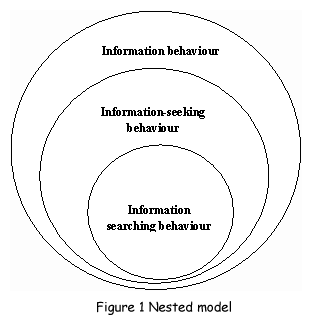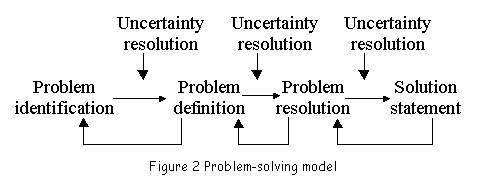Final Report
Outline
- Introduction
- Theoretical perspective
- The course of the investigation
- Current state of the analysis of data
- Conclusion
1. Introduction
This project was originally funded by a grant from the then Library Research and Innovation Centre, which subsequently became the research arm of the Library and Information Commission.
The aim of the project was to investigate several aspects of information seeking and searching in the context of a theoretical model of the problem-solving process, and incorporating existing models of successive searching and information seeking behaviour, notably the theoretical perspectives of Kuhlthau (1991, 1994) and Ellis (1983, 1989).
| Contents page | Report outline |
2. Theoretical perspective
2.1 Information seeking behaviour - the nature of the research field
Our overall perspective of the research field of information seeking behaviour is that it constitutes part of the total field of information behaviour, that is, behaviour engaged in by persons in relation to information sources and channels. Information seeking is one such behaviour and implies an active search for information and other information behaviours include, for example, the passive reception of information as when a person watches television advertisements. Information searching is defined as that mode of information seeking that involves interaction with computer-based information retrieval systems. Thus, we have a nested model, which connects all three concepts:

Information seeking behaviour has been studied from a variety of perspectives but most often in relation to different groups of people, either differentiated by discipline or by work role or the life problems of the ordinary citizen. In this Project the group consists of academic researchers of various kinds – post-graduate students, PhD researchers, academic staff, and research staff.
2.2 The problem-solving model as a theoretical perspective
The theoretical perspective adopted is that of information seeking and searching as related to problem solving. Information seeking is defined as goal-seeking behaviour, the goal being the resolution of the problem. A stage process is postulated, in which the individual proceeds from the identification of a problem for investigation (or has such a problem thrust upon them), through the definition of the problem, to its resolution and the presentation of the solution. At each stage it is suggested that some uncertainty, which originally drove the search for information, is resolved. However, the search for information may not fully resolve uncertainty and, therefore, successive searches within the same stage may be necessary, or the search may increase uncertainty and the individual may have to return to an earlier stage to resolve that uncertainty. The general model is shown in Figure 2:

2.3 Incorporating other models
Other models of information seeking can be incorporated in this general model and two have been investigated in this Project. Kuhlthau’s model (1994) of the stages of information searching is explored as a model of the activities undertaken at each phase of uncertainty resolution and Ellis’s model (1989) of the characteristics of information seeking is examined in the same way.
| Contents page | Report outline |
3. The course of the investigation
3.1 Time-table of the study
The Project was carried out over a period of twenty-four months from October 1997, with an initial Pilot phase lasting from October 1997 to March 1998. During this period the data collection instruments were tested and evaluated and, as a result, a number of changes were made in the interview schedules and questionnaires. There then followed successive periods of data collection from volunteers, as described in section 3.2 below. The project ended on 30th September 1999.
3.2 The research process at Sheffield
The Department of Information Studies has made a practice of advertising the availability of on-line searching to University researchers as part of its training of students, and the same process was used to collect participants for the project. This proved to be an appropriate strategy, as 121 participants were ultimately enrolled. Each participant was interviewed before a search was carried out, using the Pre-search interview schedule and questionnaire. (Appendix 1.1).
Appointments were made for searches to be conducted by the research assistant and, in the course of the search, all interactions with the computer were automatically logged and the conversations between the participant and the searcher were tape-recorded. Immediately following the search, the participant was re-interviewed to determine whether any characteristics of the problem had changed and what criteria were employed in judging the relevance of the information found.
Two months after the search, attempts were made to carry out a follow-up interview, to discover whether the participant had obtained any of the documents discovered in the search and what other information behaviour the participant had engaged in in the interim.
3.3 International collaboration with Dr Spink of the University of North Texas
At the same time as application for support was being made by the Sheffield team, Dr Amanda Spink of the University of North Texas (now of the Pennsylvania State University) was applying for a National Science Foundation grant under the POWRE (Professional Opportunities for Women in Research and Education) programme. A grant was awarded under the title, "Interaction in information retrieval: successive searching by usage over time".
Although Dr Spink's work related primarily to the phenomenon of successive searching for information by the same person, there was sufficient overlap in the two projects to enable the use of essentially the same research instruments. The main difference was that the Pilot phase of the Sheffield project allowed for the re-design of those instruments, whereas Dr. Spink (whose project had a duration of eighteen months) was able to incorporate only some of the changes that took place after the Pilot phase.
However, full co-operation was established between the two teams, with Dr Spink making a number of visits to the UK and Professor Wilson visiting UNT on one occasion. As a result, there is a common data set for the two projects, which is described below.
3.4 Final state of the data set
The final data set consists of 198 cases, 77 from the UNT study and 121 from the Sheffield study. Each case had the possibility of three successive collections of data: the pre-search interview, the post-search data collection, and the follow-up interview. In addition, search logs and audio tapes for the Sheffield mediated searches exist and constitute a separate data set.
Each case has potentially about 150 variables, linked to the theoretical variables under exploration. The majority of these are measured on an eight-centimetre interval scale, while other variables are measured on categorical scales – mainly dichotomous, ‘Yes/No’ variables. (Some of the variables, such as Case Number, are merely system-related.)
As analysis proceeds (using SPSS), variables are being re-coded, or used to construct derived variables as the nature of the analysis demands.
| Contents page | Report outline |
4. Current state of the analysis of data
4.1 Analysis of the Pilot Study data
The Pilot phase of the Sheffield Project was carried out from October 1997 to June 1998: twenty-two clients were accepted into the Pilot and interviews and searches were carried out with all of them. (The clients were distributed over the Faculties as follows: Architectural Studies (1); Educational Studies (2); Engineering (5); Medicine (3); Pure Science (4); and Social Sciences (7).)
A report on the analysis of this phase of the Project was presented at the Second International Conference on Information Seeking in Context, held in Sheffield in August 1998. The paper is reproduced here as Appendix 3. The Pilot Phase data were also used in preparing the first draft of a paper on cognitive styles and information seeking, this paper is now being revised in the light of the analysis of the total data set and will be submitted for publication as part of a series of papers on the Project. The latest draft of the paper appears here as Appendix 5.
4.2 Plan for the analysis of the final data set
It is intended to publish a series of papers under the general title Information seeking and searching based on analysis of the full data set. The papers will cover the analysis of the data set both in Sheffield and at Pennsylvania State University (where Dr. Spink is now located). The first of these will be a general paper describing the intentions of the Project and the theoretical framework for the investigation, based on a revision of Appendix 2 below.
Further papers are planned on:
- the relationship between cognitive style and information seeking;
- the concept of uncertainty and its relationship to other variables (see Appendix 6);
- testing the quantitative use of Ellis’s ‘characteristics’ of information seeking and Kuhlthau’s ‘stages’ (these were derived from qualitative studies and the Project has sought to operationalise the variables for quantitative research);
- disciplinary and national differences in information seeking behaviour,
- mediator/client interaction in the search process;
- successive searching and shifts in relevance judgements (Dr. Spink).
Other papers may follow as the analysis reveals potentially interesting avenues of research.
| Contents page | Report outline |
5. Conclusion
At this stage, with the data collection part of the Project completed, we can say that the design was effective and that, in both Texas and Sheffield, it was possible to obtain participants for the research, in spite of the fact that the process was potentially very time-consuming. Critical to the process in Sheffield was the fact that the Department already had an established reputation in carrying out searches for researchers as part of its on-line training programme and, in fact, some of the participants had had searches carried out in previous years.
While the analysis of the very large data set is not yet complete and several papers are planned, it can also be said that the initial analysis supports the proposition that a problem-solving framework is useful in analysing the stage of the participants' enquiries and that the concept of uncertainty is also useful in discriminating among participants. Some difficulty was experienced in using the concept because most of the participants reported high levels of certainty about what they were doing. This might be expected, since some exploratory work will undoubtedly have been done before requesting a search. However, there was sufficient variation in reported uncertainty to demonstrate the value of the concept in information seeking research.
Finally, this report is essentially an administrative document: the scientific report will appear in a series of papers which are now in preparation and some of which are attached in draft form.
| Front Page | Contents | Report outline |
Library and Information Commission Research Report 59
ISBN 1 902394 31 3 ISSN 1466-2949
Grant number LIC/RE/019